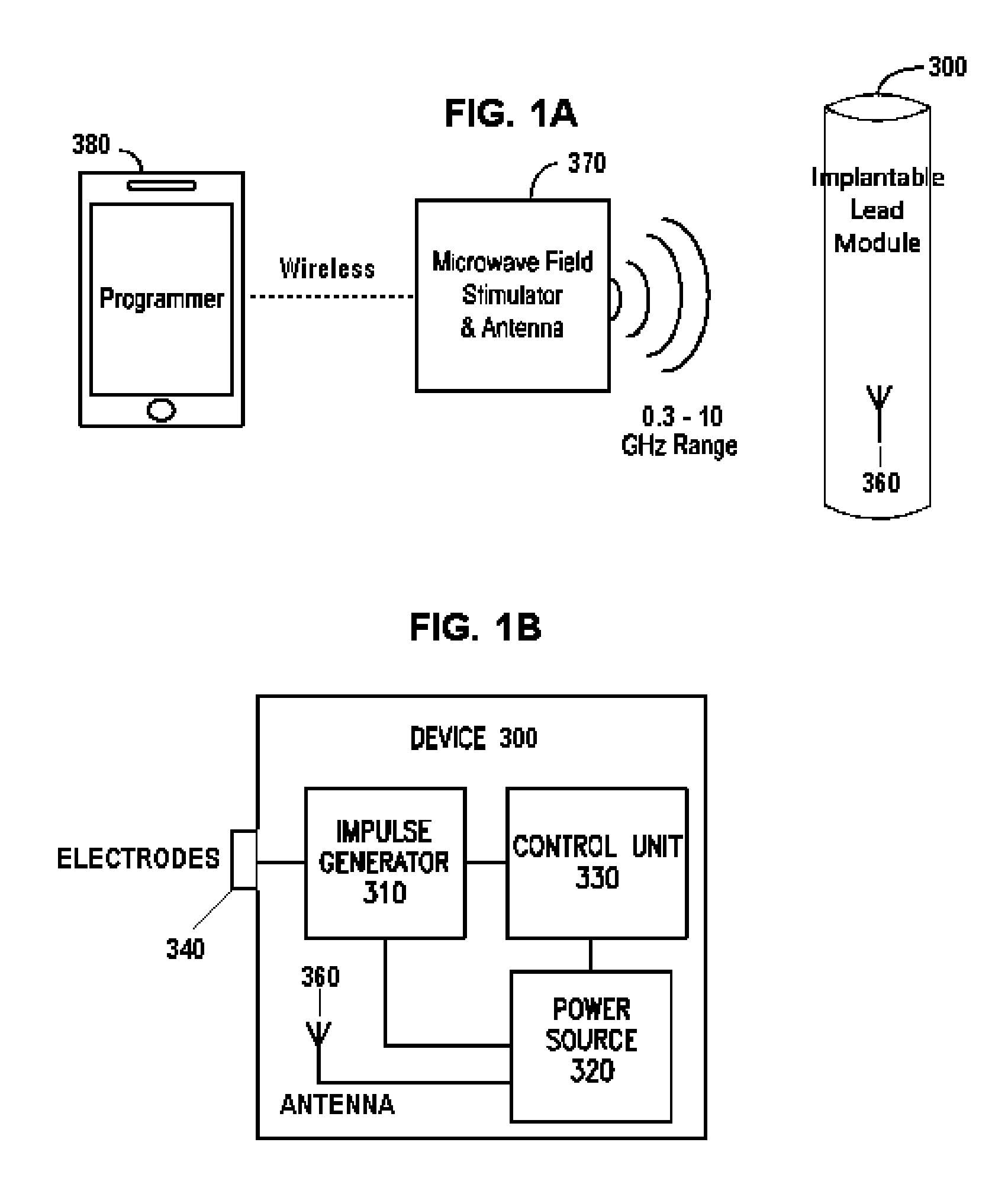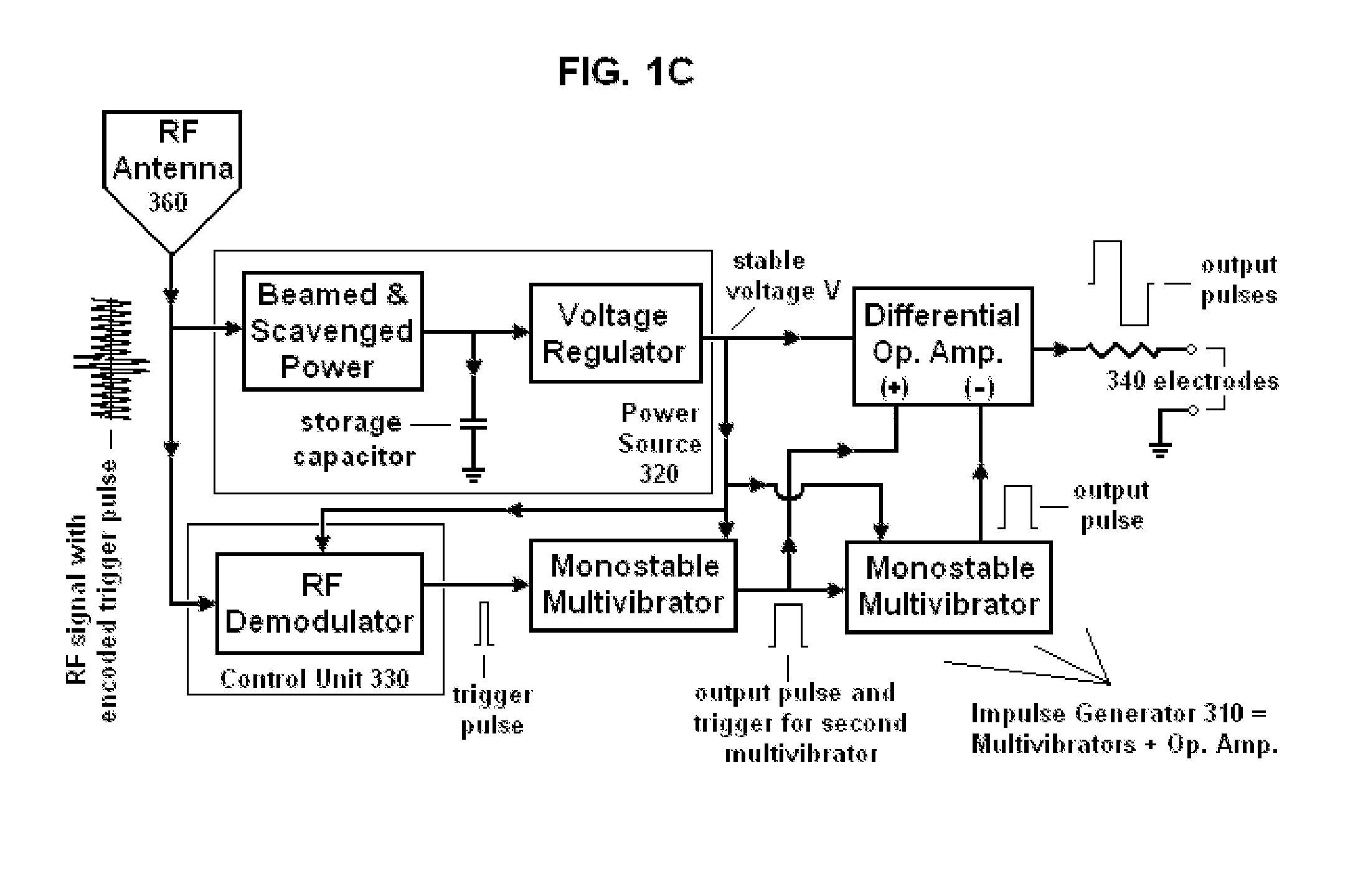[0026]In one aspect of the invention, a stimulation device comprises one or more electrodes and a pulse generator. The pulse generator is configured to generate an electrical impulse having a fixed amplitude (either fixed voltage or fixed current) and a variable duration. The electrical impulse is applied through the electrodes to excitable tissue, such as nerve or nerve ganglions, to modulate that tissue. In a preferred embodiment, the duration of the electrical impulse is varied by varying a number of fixed-duration, fixed-amplitude pulses that are applied within each electrical impulse. Varying the number of these fixed-amplitude pulses allows the stimulation device to apply an electrical impulse that will cause the nerve to reach its threshold potential without varying the amplitude of the electrical impulse.
[0027]The stimulator circuit is novel in that it removes one or more elements from conventional stimulators, without sacrificing performance. In particular, the present invention removes from conventional designs the ability of the stimulator to vary the amplitude of the stimulation pulses. Unexpectedly, one can get substantially the same stimulatory effect as that provided by conventional stimulators, by keeping waveform parameters fixed, particularly the amplitude of the electrical impulse, but by then controlling the number and timing of pulses that the nerve experiences, in order to achieve the same physiologically desirable level of nerve stimulation. In essence, this invention uses an adjustable number of fixed voltage (or fixed current) pulses with fixed duration to elicit desired changes in nerve response. These fixed voltage pulses create one long continuous pulse to the nerve to ensure that sufficient energy is delivered to the nerve to cause the nerve to reach its action potential and fire. Thus, the present invention reaches the threshold energy level for a nerve to fire by adjusting the duration of the pulse received by the nerve, rather than adjusting the amplitude of the pulse.
[0030]The present invention provides an implanted peripheral nerve stimulator, such as a vagus nerve stimulator, that can be powered using approximately plane wave or far-field electromagnetic waves with frequencies in the range of 300 MHz to 10 GHz so that the antenna transmitting energy for the stimulator's electrodes does not have to be placed in close proximity to the implanted stimulator in order for the stimulator to receive the energy. In addition, the stimulation device has relatively simple circuitry so as to consume a small amount of power, and also so that the external transmitter can be a relatively weak power source (either inherently or because it is positioned at some distance from the implanted stimulator). In particular, the present invention is advantageous for vagus nerve stimulation because the stimulation device can be implanted with minimally invasive methods, For example, the stimulation device may be implanted through a percutaneous penetration in the neck.
[0032]In another aspect of the invention, the stimulator circuit comprises either a battery or a storage device, such as a capacitor, for storing energy or charge and then delivering that charge to the circuit to enable the circuit to generate the electrical impulses and deliver those impulses to the electrodes. The energy for the storage device is preferably wirelessly transmitted to the stimulator circuit through a carrier signal from the external controller. In the preferred embodiments, the energy is delivered to the energy storage device between electrical impulses. Thus, the energy is not being delivered in “real-time”, but during the periods when the pulse is not being delivered to the nerve or during the refractory period of the nerve. For example, a typical electrical impulse may be ON for about 200 uS and then OFF for about 39,000 uS. The energy is delivered during this longer OFF time, which enables the system to use a much smaller signal from the external generator. The external generator delivers the carrier signal over the OFF period to charge the energy storage device, which then releases this energy or charge to the remainder of the circuit to deliver the electrical impulse during the 200 uS ON time. This reduces the strength of the signal required to deliver the electrical energy to the storage device within the stimulator circuit because there is a longer period of time to deliver the energy. In addition, it enhances the safety of the device because it reduces the risk that uncontrolled environmental RF energy will create an electrical connection between the nerve and the charged energy.
[0034]The electrical impulse is sufficient to modulate a selected nerve (e.g., vagus or one of its branches) at or near the target region to treat a condition or symptom of the patient. The stimulator is configured to induce a peak pulse voltage sufficient to produce an electric field in the vicinity of the nerve, to cause the nerve to depolarize and reach a threshold for action potential propagation. By way of example, the threshold electric field for stimulation of the nerve may be about 8 V / m at 1000 Hz. For example, the device may produce an electric field within the patient of about 10 to 600 V / m (preferably less than 100 V / m) and / or an electrical field gradient of greater than 2 V / m / mm. Electric fields that are produced at the vagus nerve are generally sufficient to excite all myelinated A and B fibers, but not necessarily the unmyelinated C fibers. However, by using a suitable amplitude of stimulation, excitation of A-delta and B fibers may also be avoided.
[0036]A system for implanting the stimulator preferably includes an introducer for creating percutaneous access to the target region. The introducer may include an access device such as a finder needle for creating percutaneous access through a skin surface of the patient's neck, and a cannula having an inner lumen for passage of the stimulator there through. The access device, e.g. finder needle, is introduced through the patient's skin surface in the neck and advanced to a target location, ordinarily near a vagus nerve. The target location may be within, directly adjacent to, or in contact with the carotid sheath, or it may be in close proximity with (e.g., within 1-5 mm) of the carotid sheath. The preferred target location, as well as the preferred path that the finder needle takes to that location, will depend on several factors. They include the length of the stimulator and the number of its electrodes, whether the stimulator's electrodes should produce an electric field that is intended to have particular directionality, whether deployable anchoring attachments will be used to secure the stimulator to particular surrounding tissue, as well as consideration of the electrical waveforms that may be used to preferentially stimulate the vagus nerve (including the maximum strength or amplitude of the stimulus), the likelihood that the other structures will not be damaged during the implantation or eventually co-stimulated, and the ease with which the finder needle may penetrate and actually follow the intended path.
 Login to View More
Login to View More  Login to View More
Login to View More 


